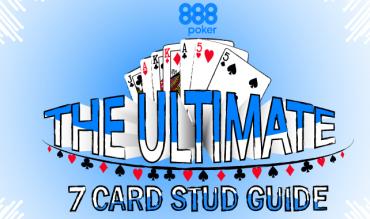Your Introduction to 7-Card Stud Games
This article will take complete novices to 7-Card Stud and instruct them in the rules, play, and basic strategy of the game. Toward that end, I will begin with a basic overview. I’ll then explain the rules and introduce a basic strategy, examining each round (or “street” as it’s known in 7-Card Stud lingo) in turn. I’ll conclude with a section on the odds that matter in 7-Card Stud and a comparison to Texas Hold’em.
Keep in mind, even as you learn this basic strategy, 7-Card Stud is a complicated game. Although this article is giving you a reasonable starting point that will be, at least, slightly profitable against a table of mediocre and poor players, it is meant to be the beginning, not the end of your poker education.
What is 7-Card Stud?
7-Card Stud is a poker game played with seven cards per player. It combines four individual exposed cards with three individual unexposed cards. From those seven cards, the player makes the best five card poker hand, following the standard poker hand ranking system.
The key to winning at 7-Card Stud, is the same as in all poker games. Either have the best poker hand at showdown or get all of your opponents to fold.
Hand Rankings in 7-Card Stud
7-Card Stud ranks 5-card poker hands exactly the same as in other forms of poker.
They are, in order from strongest to weakest, as follows:
Straight Flush: Five cards in sequence, all of the same suit. For example, Th 9h 8h 7h 6h. Among straight flushes, the higher the top card in sequence, the higher the hand. For example, Kh Qh Jh Th 9h is a better hand than 9s 8s 7s 6s 5s. Ties split the pot regardless of suit. Ac Kc Qc Jc Tc would tie As Ks Qs Js Ts.
Four of a Kind (also known as “Quads”): Four cards of the same rank. For example, Jh Js Jd Jc. Between quads, the higher rank wins. Jh Js Jd Jc beats 7h 7d 7c 7s.
Full House (also known as “Full Boat”, “Full”, or “Boat”): Three-of-a-kind and a pair. Th Td Tc 5d 5h is a full house. It would also be called “Tens full of fives”. When competing, the full house with the higher trips wins. Ts Td Tc 2c 2d beats 9h 9c 9s Ad Ah.
Flush: Five cards all of the same suit. Ah Th 7h 6h 3h is a heart flush. Flushes are ranked by their highest card. If the highest card is a tie, then they are ranked by the second highest card, etc. If all five cards are identical, but in different suits, then the pot is split. Suits do not matter, only ranks/denominations - Ac Jc 6c 4c 2c would beat As Js 5s 4s 2s.
Straight: Five cards in sequence with at least one card of a different suit. Th 9h 8s 7c 6h is a straight. The ranking of straights is determined by the highest card of the straight Qh Jd Ts 9s 8c would beat Th 9h 8s 7c 6h.
Three of a Kind (also known as “trips”): Three cards of the same rank and two unpaired cards. 8h 8s 8d Ks 2h is an example of trips. Trips of higher rank beat trips of lower rank. 8h 8s 8d Ks 2h beats 6s 6d 6h Ah Kd.
Two pair: Two cards of one rank and two cards of another rank and a fifth card. For example: 8s 8d 4h 4c Js. This hand would be called “Eights Up” or “Eights over Fours”. Two pair are ranked by the higher pair. Js Jd 2c 2d 3s would beat Ts Td 9s 9d Ah. If the higher-ranking pair is tied, the second pair would determine the winner. If both pairs are tied, the kicker (the unmatched third card) would determine the winner. Ah As 7s 7h 4c would beat Ad Ac 7d 7s 3d. One pair: Two cards of the same rank with three unmatched cards. Pairs of higher rank beat pairs of lower rank. 7h 7c beats 4h 4c. If pairs are the same then ties are broken by the unmatched cards, starting with the highest unmatched cards. 7h 7c Ad Ks 3h beats 7d 7s Ah Kh 2c.
High Card: A hand with no pair, is ranked by the value of the highest card. If that is tied, then the next highest card, etc. Jh Ts 7h 6s 2c would beat Jd 8s 7c 4d 3d.
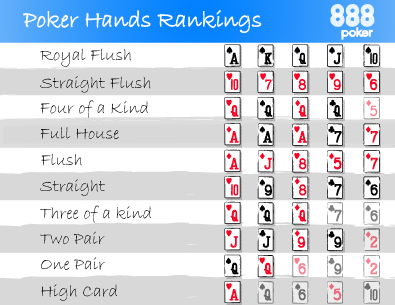
Dealing 7-card Stud
7-Card Stud is dealt in five rounds, known as “streets”, each followed by a round of betting. In the first round, known as “Third Street” (due to the three cards each player has) players are each dealt three cards, one at a time. The first two cards are placed down, and the last card dealt face up.
In the second, third, and fourth round of the deal (known as “fourth street”, “fifth street”, “sixth street” respectively, each player receives one card dealt face up.
In the fifth and final round, known as “The River” or “Seventh Street” each player receives their last card, dealt face down.
Maximum Number of Players in 7-Card Stud
Most casino and other public poker rooms deal 7-Card Stud eight-handed. Although an occasional ninth player may be seated in a tournament or a mixed game.
In the unusual event that the deck contains insufficient cards for the final round of betting, the dealer deals a mutual card for all to use, rather than an individual seventh card to each player.
This card is referred to as a community card and is the rare time that players get to share a card in Stud Poker games.
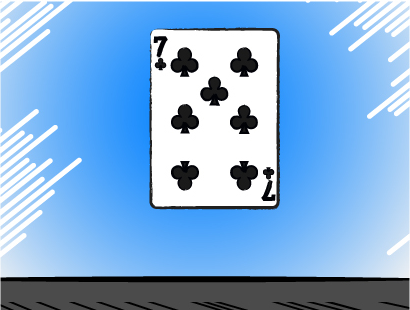
Betting Rounds in 7-Card Stud
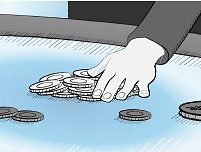 The Ante
The Ante
Prior to the deal, players make a small compulsory bet, called an “ante”. This ante is usually a small percentage of the initial bet. So, for example, if the betting limits are $10 and $20, the initial ante is normally $1. In higher-limit games it may be a larger percentage of the bet. For example, in $75/$150 7-Card Stud, the ante would typically be $15.
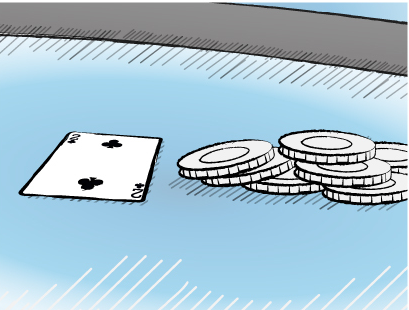 Forced Bet/Bring-In
Forced Bet/Bring-In
The betting rules in 7-Card Stud require that once the first three cards are dealt, the player with the lowest exposed card places a mandatory “forced bet” or “bring-in” – usually a third or a half of the initial bet. So, for example, in a game with betting limits of $10 and $20, the “forced bet” would be $3. That player also has the option of making a complete bet instead of just the forced bet. So, if he chose to do so, he could initiate the betting with the full $10.
If there is a tie between or among the exposed cards – let’s say two players each have a 3 and no one has a 2 – then the lowest card is determined by suit, clubs being the lowest suit, followed by diamonds, hearts, and spades. (In all other situations in 7-Card Stud, the value of the suits is irrelevant).
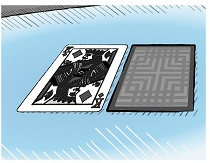 Betting Options on Third Street
Betting Options on Third Street
Each player, going clockwise around the table from the player with the forced bet, may then either call, raise, or fold. If he calls, he puts forth an amount equal to the initial bet. If he raises, he increases the amount of the bet. If he folds, he is out of the hand, puts in no money at all, turns his up card face down, and “mucks” his cards, pushing them forward toward the centre of the table.
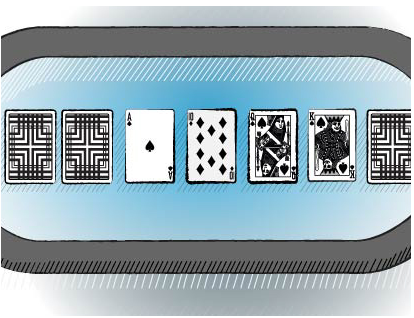 Betting Options After Third Street
Betting Options After Third Street
On all subsequent rounds of betting, the player with the highest exposed hand is first to act. There is no forced bet. He may check – passing the option of betting to the next player. Once a player makes a bet, all subsequent players must either call the bet, raise the bet, or fold.
It’s important to note that the betting rules of 7-Card Stud usually require betting limits, with two tiers. The first and lower tier of betting is set for the first two betting rounds (known as “third street” and “fourth street” respectively). The second and higher tier of betting is set for the final three betting rounds (known as Fifth Street, Sixth Street, and Seventh Street). Games are referred to by their betting limits. So, for example, if the betting limits are $10 and $20, the game is usually referred to as “$10/$20 Stud”.
There is generally a limit of three raises per round of betting, not counting the raise of the initial forced bet.
In the first round of betting, when a player comes in for only the amount of the forced bet ($3 in a $10/20 game for example), the first “raise” is only to the amount of the complete bet of $10. That “raise” is considered a completion and does not count against the total number of raises allowed in the round.
The limit applies to both the amount of the bet and the amount of the raise. So, for example, if a player on the last round of betting wants to raise in this $10/20 game, he may do so by exactly $20. No more and no less
Basic Strategy for 7-Card Stud Games
7-Card Stud Odds that Matter
You do not need to be a math whiz to play great 7-Card Stud. However, you will need to know certain odds as you determine whether to continue to call with your hand.
Here are the basic odds that will help you the most as you get started down the road of winning 7-Card Stud play. (They do not take into consideration the impact of the dead cards that would make your hand. For an analysis of the impact of dead cards, read the section on dead cards below).
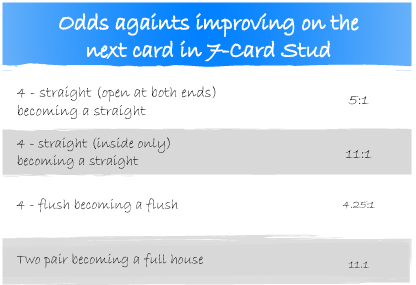
These numbers are especially useful on sixth street, of course, when you only have one more card to be dealt. You’ll want to know the chances that you’ll hit what you think will be a winning card on the river.
But this is also helpful if you have determined, for whatever reason, that you’ll fold to a bet on your next card if you don’t get a card that helps you.
It’s also important for you to know how likely it is that your hand on Third or Fourth Street will become strong final hands.
The odds below should help you with that:
Odds Against Improvement by the River in 7-Card Stud
Trips on Third Street becoming a full house 3:2
Two Pair on Fourth Street becoming a full house 7:2
4-straight on Fourth Street becoming a straight 3:2
4-flush on Fourth Street becoming a flush 5:4
Impact of dead cards on your chances of drawing a hand in 7-Card Stud
Below is an example of the powerful impact of dead cards on your chances of improvement.
If you hold a 3-Flush
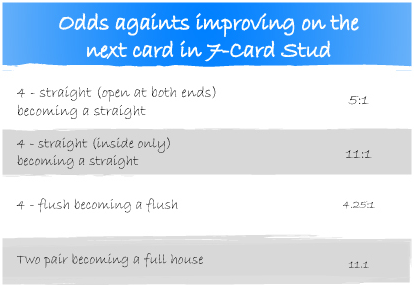
Generally, you should fold your 3- flush on Third Street if you see three or more dead flush cards
If you hold a pair and Ace kicker:
For this reason, you can play an under-pair and an Ace kicker against someone with an overpair.
Similarly, this makes a great impact when you are drawing on Fourth Street.
Here’s an example of a straight draw, with four cards to a straight.
If you hold an open-ended 4-straight:

As you can see, dead cards make a big difference in 7-Card Stud.
Differences Between 7-Card Stud and Hold’em
Many more people today have played Texas Hold’em than have played 7-Card Stud. It used to be that people said the games were similar. They really aren’t, especially as they tend to be played today, with most people playing No Limit Hold’em and Limit 7-Card Stud.
*In the very first betting round, action begins to the immediate left of the big blind. In the three subsequent betting rounds, action begins to the left of the button.
**In the first betting round, action begins with a forced bet from the lowest card. In the four subsequent betting rounds, action begins with the high hand.
7-Card Stud Variations
7-Card Stud has a myriad of variations. You regularly encounter them in home games. But only two simple variations are spread in a casino or on line. They are 7-Card Stud Hi-Lo 8-or-Better (Abbreviated "Stud8"); and Razz (7-Card Stud played only for low). I have described each briefly below.
Razz
Razz was probably invented by a guy who was really tired of losing. He decided to make the worst hands the best hands. So, in Razz, a hand with no pair is better than a pair. And the lowest high card hand wins. Simply put, Razz inverts the value of a 7-Card Stud hand, so Aces are low, the worst hand wins, and high cards are bad. Straights and flushes do not count. The best low hand is the A-2-3-4-5, known as the "wheel".
Stud8
Stud8 is 7-Card Stud, with the best high hand splitting the pot with the best low hand. However, for a low hand to win, it must be no worse than a hand with an 8 low. So, if the best low anyone can make is a 9-low, for example, then the high hand would win the entire pot.
